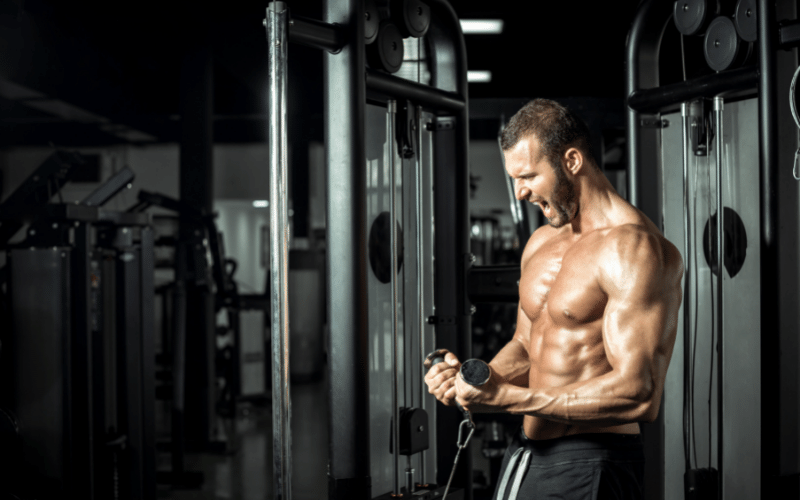Table of Contents

Cable curls are a great bicep building exercise. It is similar to the barbell curl in that both are elbow flexions movements.
The Cable Curl requires more stabilization of the wrist, elbow and shoulder joints than the Barbell Curl.
When doing cable curls, it is important not to allow your shoulder girdle to move excessively during the exercise.
The shoulders should not move more than a few inches in either direction throughout the full range of motion.
There are two styles: One Arm at a time and both arms at the same time. Both require effective core stabilization to perform this exercise correctly without compensations which could lead to injury.
cable curls Muscles Worked?
The Cable Curl is a compound exercise that primarily targets the Brachialis, Pectoralis Major and the Biceps brachii.
The Brachialis muscle originates on the anterior aspect of the humerus (upper arm bone) and inserts to the ulna (lower forearm).
The large mass of this muscle is responsible for elbow extension. The Pectoralis Major originates on the anterior aspect of the ribs and inserts into the coracoid process on top of the humerus at the shoulder joint.
This muscle is responsible for moving the arm through space in a transverse plane (forward backward).
When performing cable curls this muscle is activated to pull the upper arm into the body. The Biceps brachii has two heads that run along the posterior aspect of the humerus and is responsible for elbow flexion (bending) and supination (twisting).
The Cable Curl will not directly activate the Brachialis, Pectoralis Major or Biceps Brachii since they are not allowed to move.
They are activated indirectly through their isometric contraction against the weight of the barbell or cable machine.
Many individuals will try to compensate for a lack of strength by using momentum during cable curls. If you find yourself swinging the weight at any time.
I recommend you decrease the weight until you can perform the exercise with good form. This is not an excuse to use baby weights, so get out your big boy pants and decide how bad you want this!
Tips:
When performing cable curls start with knees bent at about 90 degrees with feet shoulder width apart or slightly closer than shoulder width.
If the weight is pulling you forward as you perform the exercise, then bring your feet closer together.
When performing cable curls keep your upper body as still as possible and only allow a few inches of movement from right to left at the shoulder.
This will ensure that you work each arm independently and not allow one side to compensate for the other.
Benefits
cable curls are a great exercise for sculpting your arms. If you can’t do them correctly, then you need to figure out how to do them!
Make sure that you know what muscles and joints will be activated and used during cable curls before attempting this exercise.
How to do cable curls
When performing cable curls, grip the bar or handle with an underhand grip. The palms of the hands should be facing your torso.
To increase stability, it is important to have a firm grasp on the weight throughout the exercise.
The starting position for cable curls will vary depending on which muscle group you are trying to target (Biceps brachii and Brachialis or Biceps Brachii and Pectoralis Major).
To activate the Biceps brachii and Brachialis, hold your upper arm close to your torso by activating the Pectoralis Major.
To target the Biceps brachii and Pectoralis Major hold your upper arm away from your torso. Grasp the bar or handle with an overhand grip and pull it up towards your chest until your elbows are fully flexed.
It is important to maintain tension on the muscles throughout the entire range of motion by not allowing momentum to take over during cable curls.
At this point gravity should be fighting against you as the weight in your hands brings you into a fully flexed position.
Tip:
When performing cable curls try not to let the weight rest in the bottom position, but rather stop and then do another rep or two slightly decreasing the range of motion for each rep. This will ensure that you are using tension throughout the entire range of motion.
cable curls Single Arm Cable Curl
When you are ready to perform cable curls with one arm, then you can switch sides each time or do a set for each side before switching sides.
The only problem I see with doing the exercise this way is that it will be VERY difficult to stabilize yourself during cable curls. If you choose to go down this route, make sure that you are in control of your entire body at all times.
Alternatives
If for whatever reason you cannot do cable curls then you can use resistance bands instead of a cable machine.
Resistance bands are also great to use if you are traveling because they take up almost no room in your luggage.

